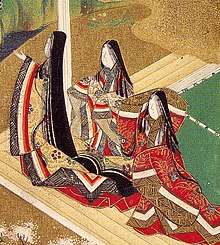Haori
The Haori (羽織) is a traditional Japanese hip- or thigh-length kimono-style jacket, worn over a kosode.
_MET_DP330781.jpg)
The haori does not close like the yukata, but is worn open or kept closed by a string that connects the lapels. During the Sengoku period, sleeveless haori were worn over the armour, like the tabard was in Europe. During the Edo period, economic growth allowed the middle class to afford the haori, yielding laws against ostentatious display of wealth by all but the warrior caste; this in turn gave birth to discreet haori designs with lavishly decorated lining.[1]
During the early 1800s, the geisha of the Tokyo hanamachi of Fukagawa began to wear haori over their kimono as part of the trend of appearing iki - stylish. Before this time, haori had only been worn by men, making them unusual and fashionable. By the 1930s, women wearing haori had become commonplace, and geisha dropped the practice.[2]
See also
| Wikimedia Commons has media related to Haori. |
- Hanten, a less formal jacket; the worker's version of the more formal haori; as winterwear, it is often padded for warmth, as opposed to the somewhat lighter happi.
- Happi, a lighter version of a hanten, traditionally worn by shop keepers, sometimes uniform between the helpers of a shop (not unlike a propaganda kimono, but for advertising business), and is now associated mostly with festivals.
- Hifu, protective padded outer vest or pinafore, worn by young children over their kimono on outings, such as Shichi-Go-San.
- Michiyuki, a traditional Japanese double-breasted overcoat, characterised by a signature square neckline (for showing off the multiple collars of the kimono worn beneath) and dual fastenings.
References
- More Japanese Haori Jackets & How To Tie A Haori Himo
- Dalby, Liza (2000). Geisha (3rd ed.). London: Vintage Random House. pp. 277, 333. ISBN 0 09 928638 6.
